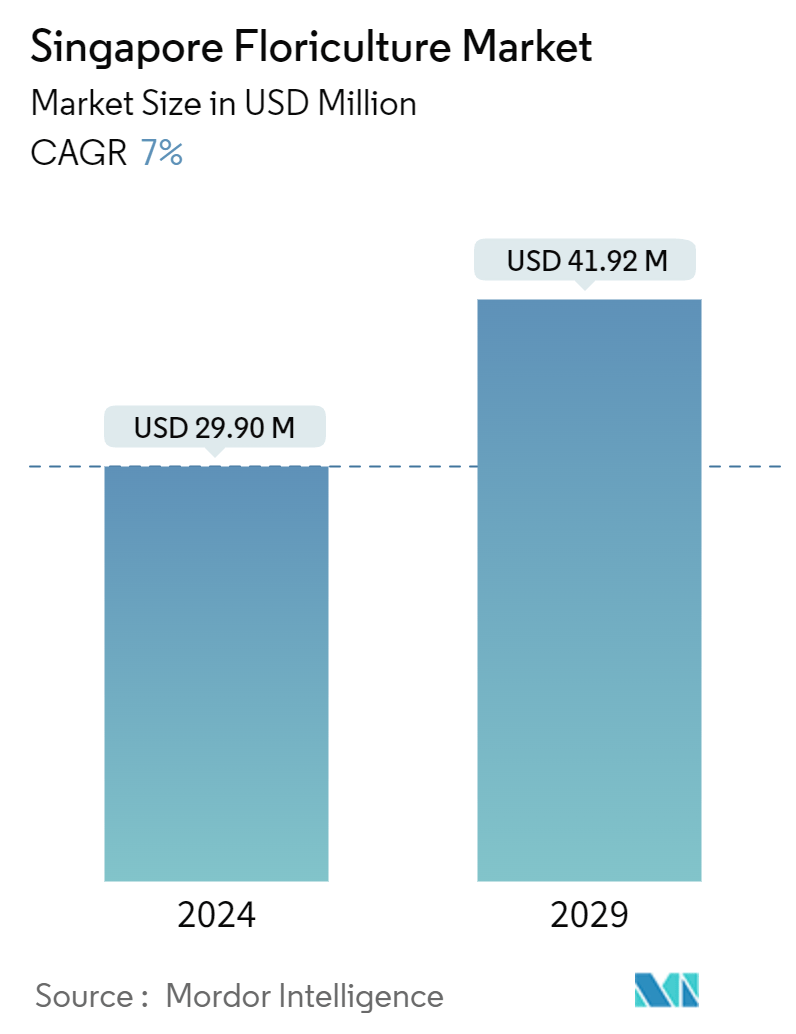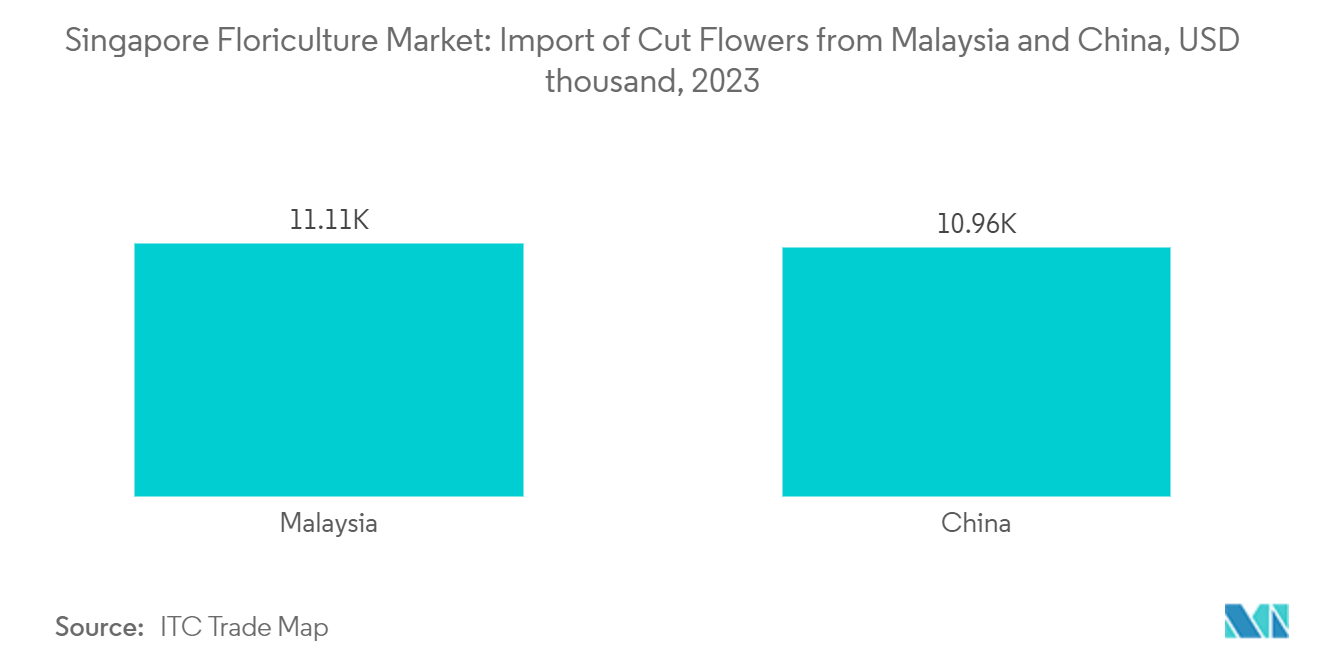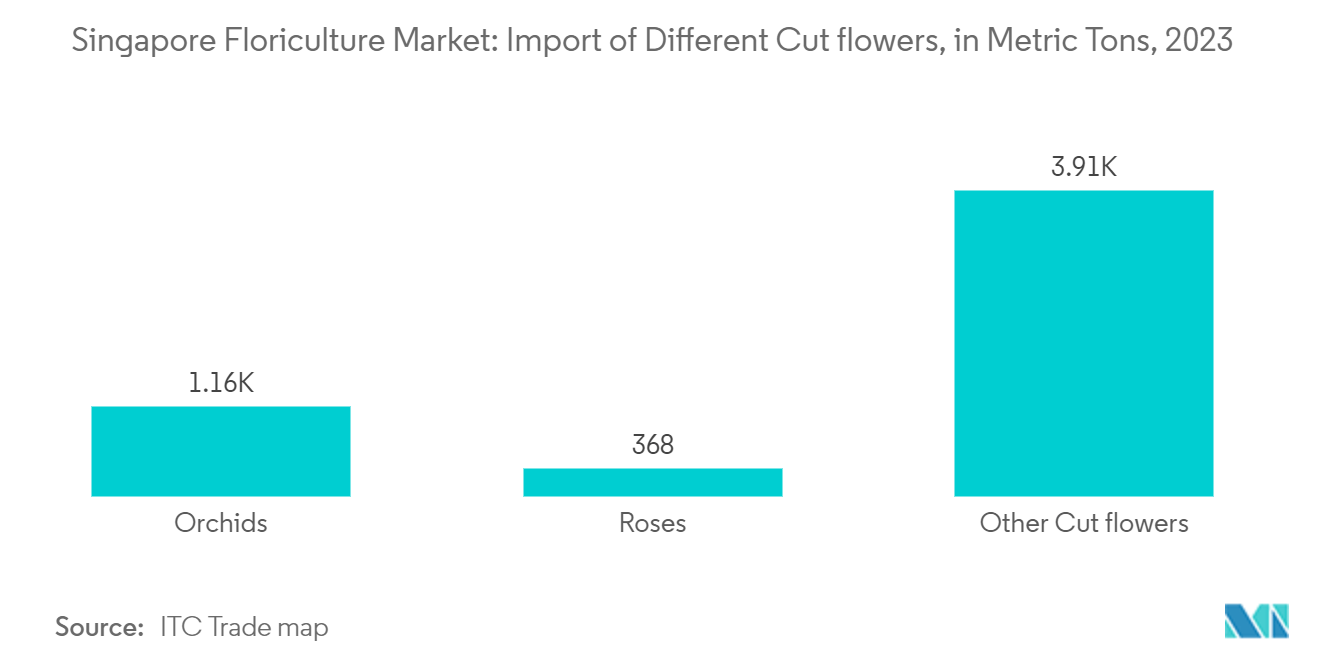Singapore Floriculture Market Size

| Study Period | 2019 - 2029 |
| Base Year For Estimation | 2023 |
| Forecast Data Period | 2024 - 2029 |
| Market Size (2024) | USD 29.90 Million |
| Market Size (2029) | USD 41.92 Million |
| CAGR (2024 - 2029) | 7.00 % |
Singapore Floriculture Market Analysis
The Singapore Floriculture Market size is estimated at USD 29.90 million in 2024, and is expected to reach USD 41.92 million by 2029, growing at a CAGR of 7% during the forecast period (2024-2029).
- The floriculture market in Singapore is characterized by its robust demand, which is driven by domestic consumption and the country's strategic position as a hub for re-exports in Asia-Pacific. Cut flowers dominate the market, driven by demand from events, weddings, and festivals. Popular flowers include roses, orchids, lilies, and chrysanthemums. Lily is used in traditional Asian medicine to treat depression and certain types of toxicities, and orchids, the national flower of Singapore, are used for decorative purposes and for creating flower arrangements or bouquets. Orchids also hold a special place in the Singaporean floriculture market as a popular cut flower due to the country's strong historical and cultural connection with the orchid industry. Singapore is known for its orchid hybridization efforts, and the flower is often used in branding and national symbols.
- Singapore’s small land area and urbanized nature limit large-scale domestic production, leading to a heavy reliance on imports to meet local demand. According to ITC Trade Map, Singapore imported cut flowers worth USD 44.1 thousand in 2023. Malaysia, China, and the Netherlands are the major flower exporters to Singapore.
- The Singaporean government has been promoting green spaces and encouraging urban greening projects, boosting the demand for ornamental plants and landscaping services. The “City in a Garden” vision aligns with this, aiming to integrate nature into the urban environment fully. Therefore, the floriculture market in Singapore is poised for continued growth and is supported by strong domestic demand, technological innovation, and government support.
Singapore Floriculture Market Trends
Malaysia and China are the Major Exporters of Flowers to Singapore
The import of flowers into Singapore from Malaysia and China plays a significant role in meeting the country’s demand for fresh flowers, which are widely used for various purposes, including decoration, religious offerings, and special occasions. Malaysia is one of the top sources due to its proximity, which reduces transportation costs and ensures fresher deliveries. In 2023, Malaysia alone accounted for 42.5% of the overall cut flower and flower buds import volume to the country. Orchids, Singapore's national flower, are highly prized and widely imported from Malaysia. Additionally, other flowers such as chrysanthemums and roses are also frequently imported from Malaysia due to the favorable growing conditions in the country that ensure a steady and reliable supply.
On the other hand, China has become increasingly important as a flower supplier, particularly in terms of volume. The country has a well-established flower industry with large-scale production, allowing it to export various flowers to Singapore at competitive prices. The most common flowers imported from China include roses, carnations, lilies, and chrysanthemums. Other cut flowers and buds such as daisies, eustoma, peonies, and others are the most imported flowers from China. For instance, in 2023, Singapore imported other cut flowers and buds worth USD 10,178 thousand from China, which was 92.8% of the total cut flowers and buds imports. Therefore, the import of flowers from Malaysia and China into Singapore is characterized by a strong and mutually beneficial trade relationship supported by favorable geographical, economic, and climatic factors.

Orchids and Roses are Popular Flowers in the Country
Singapore's import and consumption of roses and orchids are influenced by its status as a key trading center in Asia. The demand for these flowers, especially roses and orchids, stems from their cultural significance and role in festivities and as gifts. Singapore grows a substantial number of orchids, reflecting the flower's national value. However, imports of roses are essential to satisfy the local needs, mainly met by nations like Malaysia, Thailand, and Kenya. However, Singapore's orchid production has encountered difficulties due to scarce agricultural land and escalating costs, affecting the local growers' competitiveness. Therefore, the import of orchids increased in the country from 694 metric tons in 2022 to 1,157 metric tons in 2023. Through the National Parks Board (NParks), the government has stepped up efforts since 2018 to help these businesses, including supporting technological upgrades, providing agricultural advisory services, and refining land bidding systems to suit flower growers better. These initiatives aim to sustain and modernize Singapore’s orchid industry in a land-scarce environment.
Singapore's extensive free trade agreements, including those with ASEAN, have also facilitated the smooth import of roses and other flowers. Import tariffs on most goods are either non-existent or minimal, which supports the country's status as a free port. Key players in the floral import business benefit from these trade agreements, ensuring a steady supply of high-demand flowers such as roses from regional and global suppliers. Overall, the demand for roses and orchids, along with the extensive trade agreements, are estimated to increase the import of cut flowers, especially with difficulties in domestic production.

Singapore Floriculture Market News
- June 2022: Gardens by the Bay presented 150 new plant varieties during Southeast Asia's first flower trial. The event aimed to diversify plant sources and emphasize cultivars well-suited for tropical climates.
Singapore Floriculture Market Report - Table of Contents
1. INTRODUCTION
1.1 Study Assumption and Market Definition
1.2 Scope of the Study
2. RESEARCH METHODOLOGY
3. EXECUTIVE SUMMARY
4. MARKET DYNAMICS
4.1 Market Overview
4.2 Market Drivers
4.3 Market Restraints
4.4 Industry Attractiveness - Porter's Five Forces Analysis
4.4.1 Bargaining Power of Suppliers
4.4.2 Bargaining Power of Consumers
4.4.3 Threat of New Entrants
4.4.4 Threat of Substitutes
4.4.5 Intensity of Competitive Rivalry
4.5 Country Profile
4.5.1 PESTLE Analysis
5. MARKET SEGMENTATION
5.1 By Type of Flower
5.1.1 Rosa
5.1.2 Tulipa
5.1.3 Chrysanthemum
5.1.4 Gerbera
5.1.5 Freesia
5.1.6 Lily
5.1.7 Orchids
5.1.8 Nursery Stocks
5.1.9 Other Types of Flowers
6. VALUE CHAIN AND TRADE ANALYSIS
6.1 Value Chain Analysis
6.2 Distribution Channel Analysis
6.3 Trade Analysis
6.3.1 Import Analysis
6.3.2 Export Analysis
7. MARKET OPPORTUNITIES AND FUTURE TRENDS
Singapore Floriculture Industry Segmentation
Floriculture is a type of horticulture practice that involves the cultivation of flowering and ornamental plants for gardens and commercial use. The report presents an in-depth analysis of the market size of different types of flowers that are popular in the Singaporean floriculture market. The market is segmented by type of flower (rosa, tulip, chrysanthemum, gerbera, freesia, lily, orchids, nursery stocks, and other types of flowers). The report offers market size in terms of value (USD) for the segments mentioned above.
| By Type of Flower | |
| Rosa | |
| Tulipa | |
| Chrysanthemum | |
| Gerbera | |
| Freesia | |
| Lily | |
| Orchids | |
| Nursery Stocks | |
| Other Types of Flowers |
Singapore Floriculture Market Research FAQs
How big is the Singapore Floriculture Market?
The Singapore Floriculture Market size is expected to reach USD 29.90 million in 2024 and grow at a CAGR of 7% to reach USD 41.92 million by 2029.
What is the current Singapore Floriculture Market size?
In 2024, the Singapore Floriculture Market size is expected to reach USD 29.90 million.
What years does this Singapore Floriculture Market cover, and what was the market size in 2023?
In 2023, the Singapore Floriculture Market size was estimated at USD 27.81 million. The report covers the Singapore Floriculture Market historical market size for years: 2019, 2020, 2021, 2022 and 2023. The report also forecasts the Singapore Floriculture Market size for years: 2024, 2025, 2026, 2027, 2028 and 2029.
Singapore Floriculture Industry Report
Statistics for the 2024 Singapore Floriculture market share, size and revenue growth rate, created by ����vlog��ý™ Industry Reports. Singapore Floriculture analysis includes a market forecast outlook to 2029 and historical overview. Get a sample of this industry analysis as a free report PDF download.



